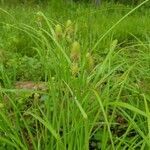Plants cespitose, short-rhizomatous. Culms 30–80 cm. Leaves 3–5.7 mm wide, glabrous. Spikes 1–2(–3), erect; lateral spikes, if present, usually pistillate; terminal spike gynecandrous; staminate portion 5–18 × 1–3.5 mm; pistillate portion ovate or oblong, 11–35 × 12–20 mm. Pistillate scales 3–4.5 × 0.5–1.1 mm, apex sharply acute or with short, scabrous awn, hidden by perigynia. Staminate scales 3.5–7.1 × 1–2 mm, apex acute, sharp or blunt. Perigynia widely radiating, the proximal reflexed, 5.8–9.7 × 1.9–3.3 mm, smooth; beak 2.1–3.8 mm, usually smooth. Achenes sides often flat, 2.3–3 × 1.1–1.4 mm, 1.9–2.5 times as long as wide; style persistent, sinuous. 2n = 56.

